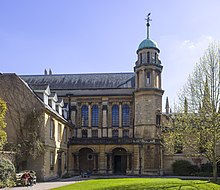Hertford College, Oxford
[4] Alumni of the college's predecessor institutions include William Tyndale, John Donne, Thomas Hobbes, and Jonathan Swift.More recently, former students have included author Evelyn Waugh, the first female Home Secretary Jacqui Smith, the civil servants Jeremy Heywood and Olly Robbins, and the newsreaders and reporters Fiona Bruce, Carrie Gracie, Krishnan Guru-Murthy, and Natasha Kaplinsky.From this period also, the main entrance of the hall moved from being a narrow passage off New College Lane to a gate on Catte Street.In the latter part of the 17th century, the principal, William Thornton, provided a proper gate for the Catte Street entrance of the hall, and decorated with a device of a drinking hart with the motto Sicut cervus anhelat ad fontes aquarum ('As the hart panteth after the water brooks', taken from Psalm 42, verse 1, but in a peculiar translation).It has been suggested that this frieze with its Latin motto is the real counterpart of the one translated for the waiting crowd by the title character of Thomas Hardy's Jude the Obscure.[7] In 1692, the political satirist Jonathan Swift was incorporated from Trinity College, Dublin, on the books of Hart Hall to receive his MA.[6]: pp.He was appointed principal from 'a very peaceful retirement' as Rector of Sudborough, where he was personal tutor to two brothers, who were both destined to be prime minister — Thomas Pelham-Holles and Henry Pelham — bringing the younger with him to Hart Hall.Newton planned to redesign the hall around a proper quadrangle, with a tutor, or angler, and students living in each angle, and common buildings along the sides.However, only two buildings in his design were ever built: one angle in the south-east corner of the Old Quadrangle (nowadays known as the Cottage), and his simple stone Chapel on the south side (consecrated 25 November 1716), which now serves as the college's Library.The proposal met immediate opposition, especially from Exeter College, exercising its old rights, and All Souls, desiring to expand northward onto the hall's land.After years of struggle, Richard Newton's statutes were accepted on 3 November 1739, and the charter incorporating 'the Principal and Fellows of Hertford College' (Principalis et Socii Collegii Hertfordiensis) was received on 8 September 1740.[6]: pp.Students were expected to work hard, and, where Newton found the university's education lacking, he supplemented it with disputations within the college.64–81 After Richard Newton's death in 1753, the principalship of the college fell to a succession of men mostly lacking the desire or energy to continue their predecessor's plan.The last tutor and vice-principal, Richard Hewitt, continued to live in his rooms without students until May 1816, when a commission declared Hertford College dissolved.[6]: pp.[citation needed] The hall was known for its adherence to the teachings of John Wycliffe; William Tyndale, translator of the English Bible and martyr, studied there.100–115 Famous Puritan graduates include Philip Nye, key adviser to Oliver Cromwell on matters of religion and regulation of the Church.An Act of Parliament was passed supporting the plan, but no move was made until a fire accidentally started by an undergraduate on 9 January 1820 destroyed almost half of Magdalen Hall's buildings.127–138, 156 During John Macbride's principalship it became clear that the growing, energetic Magdalen Hall should be incorporated as a college to match its academic standing in the university.Macbride was succeeded as principal in 1868 by his vice-principal, Richard Michell, who brought a bill before Parliament in 1873 for the incorporation of Magdalen Hall as Hertford College.The bill received significant financial support from Thomas Charles Baring, then newly elected MP for South Essex.Boyd's name appears carved on the landmark Bridge of Sighs, and he is commemorated by a memorial in the Chapel (to the left of the chancel) and a portrait in the Hall (at the west end of High Table).Boyd's partnership with the architect Thomas Graham Jackson brought about the expansion of the college and its endowment with its iconic "Anglo-Jackson" buildings.It was with the death of his son that James Percy FitzPatrick made the suggestion, after the war's end, to keep a two-minute silence each year on Armistice Day.[12] In 1922, the novelist Evelyn Waugh came up to Hertford, famously feuding with his history tutor C. R. M. F. Cruttwell (who was to become the fourth principal of the refounded college, 1930–1939), and later naming a number of odious characters after him.[citation needed] Starting from 1965, Hertford made a special effort to encourage applicants from state schools through the Hertford Scheme, established by Physics Fellow Neil Tanner, under which candidates were interviewed early, outside the standard application process, and could be offered a place at the college without having to sit the university entrance exam.Its ante-chapel houses a stained-glass window depicting William Tyndale, made in 1911 for the British and Foreign Bible Society, and installed at Hertford in 1994.The building is infamous as the site of the incident novelised in Evelyn Waugh's Brideshead Revisited in which Sebastian Flyte, returning from a Bullingdon Club bender vomits through a window into a ground-floor room.Most of the New Buildings are early 20th-century designs by Jackson, except the slightly later frontage onto Holywell Street by T. H. Hughes, on the northern side of the quad.[citation needed] Undergraduate students are accommodated for the full three or four years of their study, either on the main site or on college-owned property primarily in North Oxford and the Folly Bridge area.[26] The most recent permanent Principal of the college, from 2020 until November 2024, was former UK Ambassador to Lebanon and policy advisor Tom Fletcher.












University of Oxfordcabossedargentcross pattyCatte StreetOxfordCoordinatesMagdalen HallSister collegePrincipalEndowmentHertford College Boat Clubconstituent collegeBodleian LibraryBridge of SighsWilliam TyndaleJohn DonneThomas HobbesJonathan SwiftEvelyn WaughHome SecretaryJacqui Smithcivil servantsJeremy HeywoodOlly RobbinsFiona BruceCarrie GracieKrishnan Guru-MurthyNatasha KaplinskyByron WhitetenementNew College Laneacademic hallshome townNew CollegeposternJohn WycliffeWalter de StapledonBishop of ExeterTurl StreetExeter CollegeWilliam of WykehamThomas KenmatriculatingcloisterAll Souls CollegerecusantspuritanismJesuitRichard HoltbyAlexander BriantSenior Common RoomWilliam ThorntonPsalm 42Thomas HardyJude the ObscureTrinity College, DublinRichard NewtonSudboroughThomas Pelham-HollesHenry PelhamquadrangleJohn ConybeareBristolParliament of the United KingdomLong titleCitation56 Geo. 3Royal assentCommencementRepealed byStatute Law Revision Act 1873David DurellCharles James FoxBenjamin BlayneyAuthorized King James VersionMagdalen Collegegrammar schoolWilliam WaynfleteEnglish Civil WarPuritanHenry WilkinsonPhilip NyeJohn MacbrideLord Almoner's Professor of ArabicConvocationHilary term37 & 38 Vict.Richard MichellThomas Charles BaringBrasenose CollegeMiddle Common RoomHenry BoydchancelHigh TableThomas Graham Jacksonworld warsWorld War IWorld War IIJames Percy FitzPatrickCambraitwo-minute silenceArmistice DayC. R. M. F. CruttwellBrideshead Revisitedprotagoniststate schoolsRhodes ScholarAlain Leroy LockeGeoffrey Warnockco-educationalBrasenoseJesus CollegeSt Catherine'sWadhamFolly BridgeHolywell StreetquadranglesMichaelmasHilary termsTrinity termButteryoriel windowsante-chapelBritish and Foreign Bible SocietyLeviathan